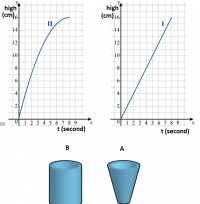shahar
Full Member
- Joined
- Jul 19, 2018
- Messages
- 497

Somebody fills two jugs by water (as in the graph) in stable rate.
The graphs describe the high of the water as function of filling water.
I can see that graph I is for jug A and graph II is for jug B. I see it from geometric reason. How Can I explain the answer? Is explaining by the words that it depends on geometric properties is enough. And how can I elaborate the answer so the answer will be a perfect answer.
Thanks for helping me.
